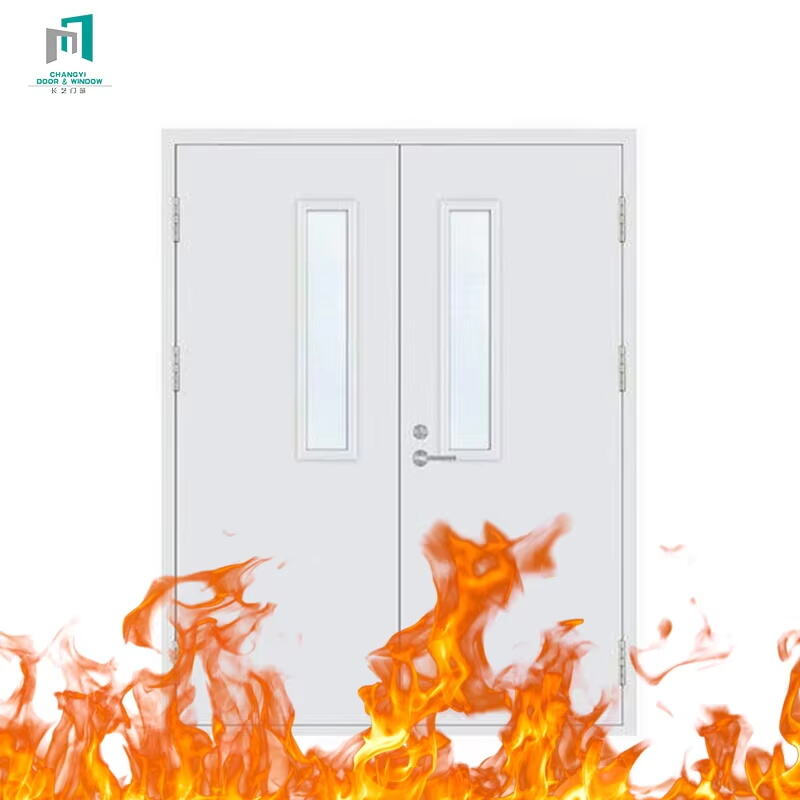Introduction: The Critical Role of Fire Doors in Building Safety
Fire doors play a really important role in today's building designs, basically serving as protection from the devastating effects of fires. When buildings have these doors installed correctly, they actually slow down how fast a fire spreads, giving people inside more time to get out before things get dangerous. Studies show that places where fire doors are properly fitted tend to see better survival chances when there's a fire emergency because these doors block both flames and smoke from spreading through the building. Most fire doors are built according to strict safety regulations, so they do double duty as both physical barriers and actual lifesavers in crisis situations. This helps make sure everyone follows proper safety rules while keeping occupants safe during those critical moments.
Why Fire Doors Matter in Modern Construction
Fire doors play a critical role in today's building designs. These specially built doors help stop fires from spreading throughout structures, making buildings safer for everyone inside. According to various studies, when buildings have proper fire doors installed, people actually stand a much better chance of surviving a fire situation. The doors buy precious minutes needed for people to get out safely and give firefighters valuable time to contain blazes before they become catastrophic. Fire door installation is required by most building codes across the country, which makes sense considering what these doors do during emergencies. With their reinforced materials and special seals, fire doors simply belong in every new construction project where occupant safety matters most.
The High Stakes of Fire Door vs Regular Door Choices
The choice between installing a fire door versus a regular door matters a lot more than most people realize. When we're talking about places where lots of people move through regularly, like office buildings or schools, getting this right literally saves lives during fires. Regular doors just don't stand up to heat and flames because they weren't built for that purpose. They won't pass fire code inspections either, which means serious trouble legally if something goes wrong. Architects, construction teams, and building managers need to know these differences inside out. Fire doors aren't just about following rules from the fire department. They actually work to stop fires from spreading faster, giving occupants more time to escape safely. Making smart decisions here creates spaces that are both legally compliant and genuinely safer for everyone who uses them day after day.
What Are Fire Doors? Defining Their Life-Saving Purpose
Fire Door Definition: More Than Just a Barrier
Fire doors serve as specially built barriers that really matter when it comes to keeping buildings safe during fires. These doors stop flames and smoke from spreading throughout the building, giving people vital protection when emergencies happen. When a fire breaks out, these doors help create separate sections inside the building, so escape routes stay clear and people can get out without being blocked by smoke or fire. Before they're installed, fire doors go through strict tests to determine how long they can hold back heat and flames, something that's crucial for any proper fire safety system. Unlike normal doors found throughout most buildings, fire doors are made stronger and thicker so they can actually resist fire for set periods of time. This gives building occupants precious extra minutes to reach safety during evacuations.
Core Components: Steel, Intumescent Seals, and Self-Closing Mechanisms
Knowing what goes into making fire doors work properly really matters when it comes to getting them to do their job right. Most fire doors are made with steel because it holds up well against high heat and lasts longer than other materials. But steel isn't the whole story. Fire doors also have these special seals called intumescent ones that actually grow bigger when they get hot, sealing gaps where smoke might escape. That's pretty smart design if you think about it. There's another important part too - the automatic closing device. When someone opens the door, this mechanism kicks in so the door shuts on its own again. This helps stop fires from spreading through corridors and rooms that haven't caught fire yet. All these different parts working together turn what looks like just another door into something much more advanced, providing real protection in places where fires can start unexpectedly.
Key Differences Between Fire Doors and Regular Doors
Materials and Construction: Steel vs Untreated Wood
Most fire doors are built with steel or other materials that resist flames, unlike standard wooden doors which aren't treated for heat resistance. The way these doors are constructed makes all the difference when there's an actual fire situation. Steel gives fire doors extra toughness and helps them hold up against intense heat, which is why they pass those strict safety tests required by building codes. Beyond just being stronger, this construction choice means regular doors would fail quickly while fire doors can actually slow down the spread of flames. That's why architects and builders insist on installing properly rated doors throughout commercial buildings and residential complexes alike.
Fire Resistance Ratings: Understanding 30/60/90-Minute Classifications
Fire doors get classified according to how long they can hold back flames and intense heat, typically rated at 30, 60, or even 90 minutes. Architects and building safety experts rely heavily on these ratings when planning structures that need to protect people during fires. Regular doors just don't have these fire ratings, so they simply won't cut it when lives are at stake in emergency situations. These different classifications give professionals a clear way to assess door performance in real life safety scenarios, which explains why fire doors remain such a fundamental part of any serious fire protection plan.
Functionality: Compartmentalization vs Basic Partitioning
Fire doors work by creating separate sections inside buildings, which helps stop fires from spreading quickly and keeps escape paths clear during emergencies. These specialized doors actually maintain safe areas throughout structures where people can take shelter until help arrives. Regular household doors just divide spaces but won't hold up against flames for long periods. They basically act as walls between rooms without providing much protection against heat or smoke. When property managers grasp what fire doors really do about reducing risk factors, they start making better choices about where to install them in new constructions or renovations. Smart building practices always consider these critical safety features from day one rather than adding them as afterthoughts later on.
Safety Features: Smoke Seals vs Standard Door Gaps
Smoke seals are among the most important safety elements found in proper fire doors. These seals work to block off spaces where smoke might otherwise escape, stopping it from spreading throughout a building. Regular doors just don't have these kinds of essential parts built into them. When fires break out, having those smoke seals makes a real difference for people trying to get out safely because they stop deadly smoke from getting into lungs. For anyone concerned about overall building protection against fires, spending money on quality fire doors with good smoke sealing capabilities isn't just smart—it's absolutely necessary when considering all the different ways a fire can endanger lives and property.
Benefits of Fire Doors: Beyond Basic Compliance
Life-Saving Time Creation for Safe Evacuation
Fire doors give those extra crucial minutes when alarms go off, making it much safer for everyone to get out. Research shows that just those few additional minutes can make all the difference between life and death in many cases. Fires are deadly serious business, so putting money into proper fire doors really does show concern for people's lives and their safety. When fire spreads slower and smoke doesn't fill rooms as quickly, occupants actually have time to find exits and escape before things get too dangerous. That's why good quality fire doors matter so much during emergencies. They literally save lives by buying precious seconds that might otherwise cost them everything.
Property Protection Through Fire Containment
Fire doors do more than just save lives they also protect buildings from serious damage when fires break out. These doors stop flames from spreading throughout a structure, which means less overall destruction happens during emergencies. Think about it this way if a fire starts in one room, good quality fire doors can contain it there instead of letting everything go up in smoke. Property owners often overlook their value until disaster strikes, but those who invest in proper fire door installation typically see major savings down the road. For anyone looking to safeguard both people and assets, making sure fire doors are part of the overall safety plan makes absolute sense. After all, nobody wants to lose valuable possessions or face huge repair bills after a preventable incident.
Insurance Advantages and Legal Compliance
Putting in place fire doors brings real benefits for insurance costs too, with many companies seeing their premiums drop after installation since these doors help reduce fire risk. Most insurers actually give better rates when buildings have proper fire prevention features installed throughout. Beyond just saving money though, there's another important angle here. Building codes require certain fire safety standards, and failing to follow those rules can result in serious penalties down the road. We've seen cases where landlords got hit with thousands in fines simply because they didn't install required fire doors. So while safety remains the primary concern, smart property managers know that fire doors serve double duty by keeping both occupants safe and avoiding potential legal headaches later on.
Conclusion: Recap the importance of fire doors in fire safety.
Fire doors are absolutely vital for keeping buildings safe during fires, acting as barriers that contain flames and protect people and possessions. Regular doors just separate spaces and look nice, while fire doors are built specifically to hold back fire, smoke, and dangerous gases when things go wrong. These special doors work because they're made from materials that resist heat and have features such as automatic closers that kick in even if nobody remembers to shut them. The extra few minutes they buy can mean the difference between life and death for anyone trying to get out or firefighters battling the blaze. Before being installed, all fire doors undergo strict testing to make sure they actually work under extreme conditions, which is why building codes require them in so many places. Properly installed and maintained fire doors don't just follow regulations they save lives every day, something that shouldn't be overlooked by property owners or managers.
FAQ Section
What is the primary purpose of a fire door?
The primary purpose of a fire door is to compartmentalize a building during a fire, preventing the spread of flames and smoke, thereby allowing safe evacuation and reducing potential harm to occupants.
What are the core components of a fire door?
Fire doors typically include components like steel construction for durability, intumescent seals for blocking smoke, and self-closing mechanisms to ensure that doors close automatically to contain fires effectively.
How do fire doors differ from regular doors?
Fire doors are made of fire-resistant materials such as steel and are designed to withstand fire for specific durations, whereas regular doors usually lack such fire-resistant properties and fail to offer effective protection during a fire.
Why are fire doors important in high-risk areas?
Fire doors are crucial in high-risk areas like kitchens and electrical rooms to prevent the spread of fires, ensuring these zones are protected and adhere to best safety practices.
What are the benefits of installing fire doors?
Installing fire doors provides benefits such as enhanced life safety during evacuations, fire containment to protect property, insurance advantages through reduced premiums, and compliance with legal safety standards.

